|
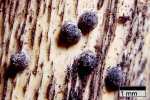
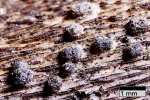
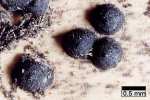
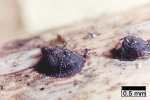
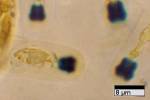
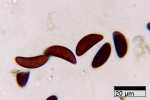
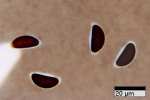
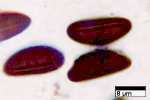
|
Rosellinia amblystoma Berl. & F. Sacc.
Stromata scattered or in small groups, 0.5-0.75 mm diam x 0.4-0.5 mm high, hemispherical, black,
flat-topped to slightly conical, uniperitheciate or containing 2(-3) perithecia, a black stromatic ring usually present on host surface surrounding the base of the stroma.Subiculum absent.
Ostioles slightly papillate.
Asci cylindrical, short-stipitate, with apical apparatus amyloid, 4.5-5.5 x 4.5-5.5 µm, cuboid with a lateral rim.
Ascospores 17-20 x 7.5-9.5 µm, ellipsoid-inequilateral, at times crescent-shaped, brown
to dark brown, with a straight germ slit almost spore-length on the flattened side. A thin gelatinous sheath is present all around the ascospores.
Specimen examined: Pyrénées Atlantiques (64): Osserain, village, 06 Nov. 2003, JF-03215, on Pseudosasa japonica (bamboo).
Notes. Rosellinia amblystoma is a controversed name for a species which has been excluded from Rosellinia by Petrini (1993) and considered as belonging to Astrocystis on account of the Acanthodochium anamorph and the absence of subiculum. For the same reasons, Laessoe & Spooner (1994) applied to this taxon the name Astrocystis sublimbata (Durieu & Mont.) S. Hughes, considering it is conspecific with Rosellinia amblystoma and possibly with R. muroiana Hino & Katum. On the other hand, Ju & Rogers(1990,1994), San Martin & Rogers (1995), who do not recognize Astrocystis, named this taxon Rosellinia sublimbata (Durieu & Mont) Pass. apud Thüm. On account of variations in conidial sizes observed in culture and variations in the presence or absence of a hyaline sheath around ascospores, Ju & Rogers (1994) consider Rosellinia sublimbata as " probably a complex of closely related species". In the present study, this taxon is kept in Rosellinia for convenience's sake, awaiting a better knowledge of this complex and a full agreement of the different specialists of Xylariaceae.
In the field, this species is characterized by a black stromatic zone at the base of the stromata, and the absence of subiculum even when immature. Its host-specificity for bamboo s. l. is likewise a useful feature for its identification.
Rosellinia amblystoma has a worlwide distribution, in temperate and tropical regions. In Europe,
it is known from Eire, France, Portugal, Spain and U. K.(Laessoe & Spooner, 1994).
|